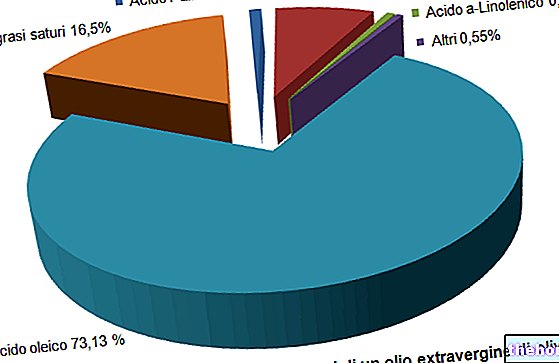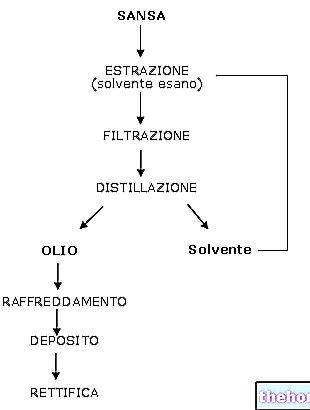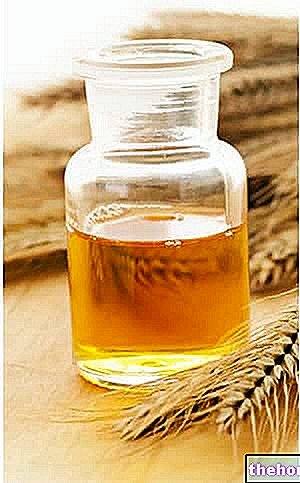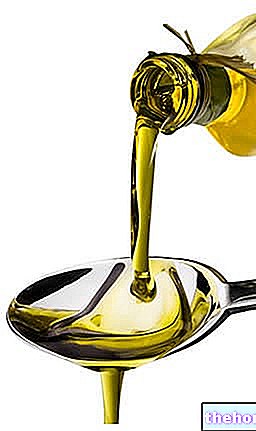Generality
L "Borage seed oil (Borago officinalis) - cold pressed - represents the most important source of gamma-linolenic acid (GLA), a semi-essential fatty acid belonging to the omega-six family.

On the other hand, natural sources of GLA are very rare, contained in important percentages only in borage oil and in evening primrose and black currant oil.
The usefulness of introducing dietary supplements based on gamma-linolenic acid derives from the decrease in the activity of the Delta-6 desaturase enzyme (involved in the conversion of linoleic acid into GLA) during aging, in the course of various diseases (such as diabetes) and in the presence of a diet rich in saturated or hydrogenated fatty acids, but low in vitamins.
Indications
Why is borage oil used? What is it used for?
The virtues of borage oil are linked to the role of GLA in the human organism.
This fatty acid, by converting into dihomogamma-linolenic acid (DGLA), favors the production of prostaglandins of the series 1 (PGE1), endowed with antiplatelet, cardioprotective, antiatherogenic, vasodilator and anti-inflammatory activity.
The dihomogamma-linolenic acid also antagonizes prostacyclin and PGE2 (which have opposite effects to PGE1) and is endowed with eudermic and immunostimulating properties.
Many therapeutic properties ascribed to borage oil are based on these metabolic assumptions, which include:
- reduction of cardiovascular risk,
- improved skin and nail health,
- reduction of symptoms associated with rheumatoid arthritis, premenstrual syndrome, eczema and psoriasis,
- utility in the control of hypertension and high cholesterol.
Despite what has been said so far, we must remember a very important metabolic detail: once ingested, GLA acid is easily converted into dihomogamma-linolenic (DGLA), by an elongase.

High levels of arachidonic acid depress immune activity and enhance the inflammatory response, just the opposite of what their precursor in Borage seed oil does.
Therefore, in order to preserve the biological usefulness of GLA, it is recommended to take borage oil in the context of a healthy diet, low in saturated fatty acids and rich in polyunsaturated fatty acids of the omega 3 series.
Properties and Effectiveness
What benefits has borage oil shown during the studies?
The scientific literature brings numerous examples relating to the "usefulness" of borage oil - and more precisely of GLA - in the clinical setting.
From both experimental evidence and clinical trials, it emerges that the "adequate intake of borage oil in an anti-inflammatory dietary context could:
- It is useful in controlling the symptoms and clinical evolution of inflammatory disorders, such as rheumatoid arthritis, Sjogren's syndrome and rectal ulcerative colitis;
- Improve the clinical course of dermatological diseases such as atopic dermatitis;
- To prove invaluable in the course of osteoporosis, diabetic neuropathy, respiratory distress, hypertension and hyperlipidemia (mostly experimental data).
Furthermore, very recent evidence would demonstrate a certain activity of GLA in the control of cancerous pathologies such as cerebral glioma.
The ameliorative activities of borage oil against dyskinesias and premenstrual syndrome seem not adequately supported.
Dosage and method of use
How to use borage oil
The dosages of borage oil proposed in the various studies vary significantly depending on the pathology studied and the GLA content.
Classically, in the management of rheumatoid arthritis dosages of GLA ranging between 360 mg and 2.8 g per day have been proposed, divided into several assumptions.
For the treatment of atopic dermatitis, however, the most used dosages are between 320 and 480 mg per day, while the management of hypertriglyceridemia can make use of generally higher doses.
It is recommended, especially in those who make chronic use of borage oil, to ascertain the source of extraction and its degree of purity, especially in terms of alkaloids present.
Side effects
Borage oil may increase the incidence of gastrointestinal reactions such as nausea, vomiting, flatulence, diarrhea and bloating.
Although rarely, and especially in patients undergoing piscopharmacological therapy, unpredictable behavioral disturbances have been described following the use of this supplement.
Contraindications
When Should Borage Oil Not Be Used?
The use of borage oil is contraindicated in patients hypersensitive to the active ingredient.
Pharmacological interactions
What drugs or foods can modify the effect of borage oil?
There are several noteworthy drug interactions between borage oil and active ingredients.
More precisely, the contextual assumption of:
- Borage oil and neuroleptic drugs such as chlorpromazine could induce unexpected changes in behavior;
- Borage oil and non-steroidal anti-inflammatory drugs, rather than antithrombotic agents or oral anticoagulants, could enhance the haemofluidifying action;
- Borage oil and garlic o Ginkgo biloba could increase the risk of bleeding.
Precautions for use
What do you need to know before taking borage oil?
The use of borage oil should be avoided during pregnancy, during the subsequent breastfeeding period and before any surgery.
Great care, as well as close medical supervision, should also be required in patients with disorders such as epilepsy, schizophrenia and coagulation disorders.
The same precautions would be required in patients undergoing drug therapy with neuroleptic drugs and oral anticoagulants.
According to recent evidence, borage oil may have alkaloids.
Other Foods - Oils and Fats Peanut Butter Cocoa Butter Butter Greaves Wheat Germ Animal Fats Margarine Vegetable Cream Tropical Oils and Fats Frying Oils Vegetable Oils Peanut Oil Borage Oil Rapeseed Oil Krill Oil Poppy Seed Oil Seed Oil Pumpkin Avocado oil Hemp oil Safflower oil Coconut oil Cod liver oil Wheat germ oil Linseed oil Macadamia oil Corn oil Almond oil Hazelnut oil Walnut oil Olive oil Palm oil fish Rapeseed oil Rice oil Pomace oil Seed oil Soybean oil Grapeseed oil Extra virgin olive oil Sesame seeds and sesame oil Lard OTHER ARTICLES OILS AND FATS Categories Food Alcoholics Meat Cereals and derivatives Sweeteners Sweets Offal Fruit Dried fruit Milk and Derivatives Legumes Oils and Fats Fish and fishery products Salami Spices Vegetables Health recipes Appetizers Bread, Pizza and Brioche First courses Seconds pi acts Vegetables and Salads Sweets and Desserts Ice creams and sorbets Syrups, liqueurs and grappa Basic Preparations ---- In the Kitchen with leftovers Carnival recipes Christmas recipes Light diet recipes for Celiacs Recipes for Diabetics Recipes for Holidays Recipes for Valentine's Day Recipes for Vegetarians Protein Recipes Regional Recipes Vegan Recipes




























